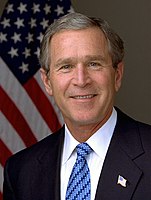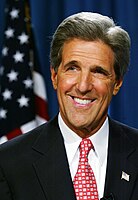
Back الانتخابات الرئاسية الأمريكية 2004 Arabic Президентски избори в САЩ (2004) Bulgarian Predsjednički izbori u Sjedinjenim Američkim Državama 2004. BS Eleccions presidencials dels Estats Units de 2004 Catalan 2004 nièng Mī-guók cūng-tūng sōng-gṳ̄ CDO ھەڵبژاردنی سەرۆکایەتیی ویلایەتە یەکگرتووەکانی ئەمریکا (٢٠٠٤) CKB Volby prezidenta USA 2004 Czech Præsidentvalget i USA 2004 Danish Präsidentschaftswahl in den Vereinigten Staaten 2004 German Προεδρική εκλογή των Ηνωμένων Πολιτειών 2004 Greek
| |||||||||||||||||||||||||||||
538 members of the Electoral College 270 electoral votes needed to win | |||||||||||||||||||||||||||||
|---|---|---|---|---|---|---|---|---|---|---|---|---|---|---|---|---|---|---|---|---|---|---|---|---|---|---|---|---|---|
| Opinion polls | |||||||||||||||||||||||||||||
| Turnout | 60.1%[1] | ||||||||||||||||||||||||||||
| |||||||||||||||||||||||||||||
 Presidential election results map. Red denotes states won by Bush/Cheney and blue denotes those won by Kerry/Edwards. Light blue is the electoral vote for John Edwards by a Minnesota faithless elector. Numbers indicate electoral votes cast by each state and the District of Columbia. | |||||||||||||||||||||||||||||
| |||||||||||||||||||||||||||||
| Democratic Party | |
|---|---|
| Republican Party | |
| Minor parties | |
| Related races | |
| |
Presidential elections were held in the United States on November 2, 2004. Incumbent Republican President George W. Bush and his running mate, incumbent Vice President Dick Cheney, were re-elected to a second term. They narrowly defeated the Democratic ticket of John Kerry, a senator from Massachusetts, and his running mate John Edwards, a senator from North Carolina.
Bush and Cheney were renominated by their party with no difficulty. Former Vermont governor Howard Dean emerged as the early front-runner in the 2004 Democratic Party presidential primaries, but Kerry won the first set of primaries in January, and then clinched his party's nomination in March after a series of primary victories. Kerry chose Edwards, who was the runner-up in the primaries, to be his running mate. Foreign policy was the dominant theme throughout the election campaign, particularly Bush's handling of the war on terror and the 2003 invasion of Iraq. Bush presented himself as a decisive leader and attacked Kerry as a "flip-flopper". Kerry criticized Bush's conduct of the Iraq War, despite having voted for it himself. Domestic issues were debated as well, including the economy and jobs, health care, abortion, same-sex marriage, and embryonic stem cell research.
Bush won by a narrow margin of 35 electoral votes and took 50.7% of the popular vote. Bush swept the South and the Mountain states and took the crucial swing states of Ohio, Iowa, and New Mexico, the last two flipping Republican. Although Kerry flipped New Hampshire, Bush won both more electoral votes and states than in 2000. Ohio was the tipping-point state, and was considered to be the state that allowed Bush to win reelection. Some aspects of the election process were subject to controversy, although not to the degree seen in the 2000 presidential election. Bush won Florida by a 5% margin, a significant improvement over his razor-thin victory margin in the state four years earlier which led to a legal challenge in Bush v. Gore. This was the first presidential election since 1988 where the Republican nominee won the popular vote, the last where they won a majority of the vote, and the last where they won the popular vote until 2024. It was also the first election since 1988 where any candidate received a majority of the popular vote. As of 2025, this was the most recent presidential election in which the winning candidate won fewer than 300 electoral votes. It is also the most recent in which the Republican candidate won Colorado, New Mexico and Virginia.
This remains the most recent presidential election in which both major party candidates flipped at least one state, and the only presidential election since 1984 in which the incumbent Republican president won a second consecutive term. At the time, Bush also received the most popular votes in history, a record which would be broken in the 2008 presidential election. This was the last time a Republican won the majority of the popular vote. Bush also became the only incumbent president to win reelection after previously losing the popular vote and was the only Republican to win the popular vote between 1992 and 2020. In addition, this was one of only two elections in the 21st century in which a candidate from either party won fewer than 20 states, with the other being 2024, where Kamala Harris also won only 19 states.
This is the earliest presidential election of which the presidential and vice presidential candidates of both major parties are still alive. Furthermore, this election is the most recent to date in which both major party tickets did not include a woman or person of color.
- ^ "National General Election VEP Turnout Rates, 1789-Present". United States Election Project. CQ Press. Archived from the original on July 25, 2014. Retrieved February 21, 2023.
Cite error: There are <ref group=lower-alpha> tags or {{efn}} templates on this page, but the references will not show without a {{reflist|group=lower-alpha}} template or {{notelist}} template (see the help page).

